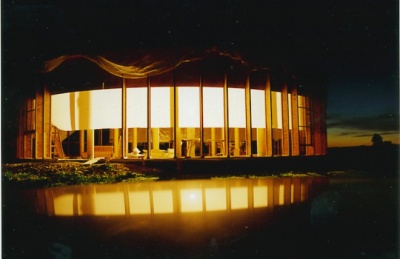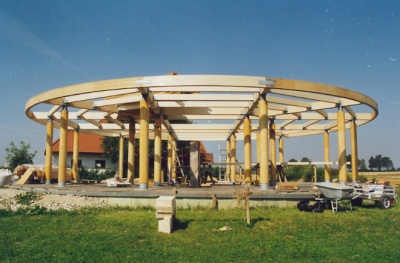Passive House Disk Salzkammergut
Built as one of the first Passive Houses in Upper Austria, the house was presented with the award "House of the Future" in 2000. Due to the optimising measures conducted, the demonstration project has been built without incurring extra costs compared to the then current design under the Austrian Building Code. The basic idea arose from the opportunity of reusing a discarded trade-fair pavilion as a basic structure for building a single family home. In order to get the most out of the existing structure the future building shape was adjusted to it. Despite the high standard, living comfort and extraordinary architecture, the construction costs of € 1,240. -/m² were no higher than those of conventional single-family homes at that time. The one-storey single-family house in lightweight construction has a diameter of 14.7 m and an usable living area of 140 m². Energy concept Insulated to extremely high degree building envelope and windows, no thermal bridges, air tightness. Low-tech concept All HVAC equipment with controlled living space ventilation, including heat recovery and hot water preparation, is accommodated in a compact unit in the toilet. Main features: • Annual heat demand: 13.7 kWh/m² • Heat load (PHPP): 10.2 W/m² • Airtightness (measured), n50: 0.41 1/h • Transmission heat losses of particular components: • Exterior walls 0.10 W/m²K • Roof 0.08 W/m²K • Ground floor 0.12 W/m²K • Exterior doors incl. frame 0.45 W/m²K • Windows incl. frame 0.78 W/m²K
Evaluation:
The average consumption of green energy for heating, hot water and ventilation for a period of 8 years was only 1.580 kWh/a, which corresponds to an average energy demand for heating, hot water and ventilation of 11.25 kWh/m².a. As a result the actual energy consumption is even significantly lower than calculated. After 7 years the air tightness pressure test was repeated. The result achieved, n50 = 0.42 1/h, is virtually identical to the original measurement. A thermographic measurement, conducted after 8 years, confirmed the excellent state of the building as well. Air quality inside the house Due to controlled ventilation and extraction, all rooms are supplied with fresh air throughout the year and the CO2 concentration never exceeds 800 ppm.
Awards received for the Salzkammergut Passive House:
Haus der Zukunft 2000 - won Energy Globe Award 1999 - nominated OÖ. Umweltschutzsonderpreis 1998 - won
Sources:
More information about Passive House Disk Salzkammergut:

